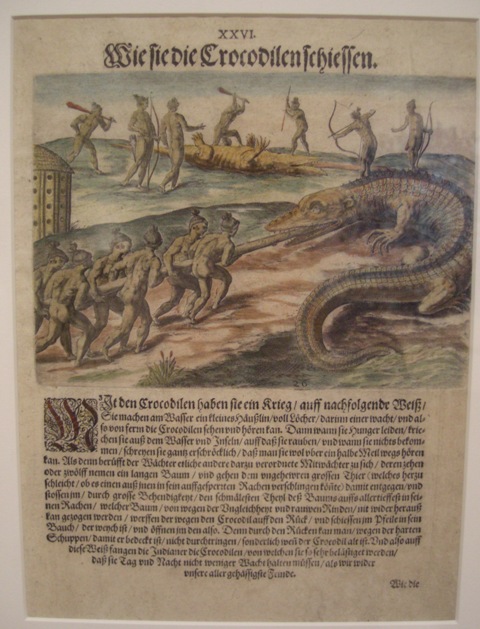Written by Jocelyn Boigenzahn, Curatorial Intern
In 2013, Florida is commemorating the 500-year anniversary of the arrival of Europeans and Africans in the Americas. Juan Ponce de León’s expedition to Florida in 1513 marked a major turning point in world history. When Europeans and Africans met Native Americans on the shores of the land we now call Florida, life on both sides of the Atlantic Ocean was forever changed. In 1564, Jacques Le Moyne became the first European artist to visit Florida. He made drawings and watercolors of the Timucua, a people indigenous to the northern part of the state. Despite their inaccuracies, these prints were for decades the only images of Florida flora, fauna, and peoples known to the Old World.

Theodor de Bry (Flemish 1528 – 1598), after Jacques Le Moyne de Morgues (c. 1533 – c. 1588), Hunting Alligators, 1591, Engraving, Museum purchase in honor of Congressman Charles E. Bennett, AP.2002.1.3.
In 1591, Dutch engraver and goldsmith Theodor de Bry published Grand Voyages, which contained engravings of Le Moyne`s watercolors (now lost). Although Theodor de Bry never traveled to the Americas, the images he created helped to shape the European perception of Native American cultures and the land they inhabited.
De Bry’s renditions of Le Moyne’s sketches are both historically significant and highly controversial. Scholars point out that certain aspects of the engravings do not match later depictions of the Timucua Indians encountered by the French in northeastern Florida, and contend that de Bry certainly altered the images prior to publication.
Artistic license is evident in several of the images such as the one shown here with its fantasticly oversized Alligator, on display in the La Florida exhibition at the Cummer, through October 6th.


